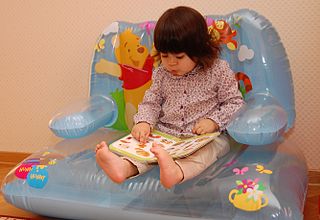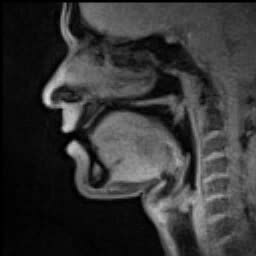Related Research Articles
Language acquisition is the process by which humans acquire the capacity to perceive and comprehend language, as well as to produce and use words and sentences to communicate.
Nature versus nurture is a long-standing debate in biology and society about the relative influence on human beings of their genetic inheritance (nature) and the environmental conditions of their development (nurture). The alliterative expression "nature and nurture" in English has been in use since at least the Elizabethan period and goes back to medieval French. The complementary combination of the two concepts is an ancient concept. Nature is what people think of as pre-wiring and is influenced by genetic inheritance and other biological factors. Nurture is generally taken as the influence of external factors after conception e.g. the product of exposure, experience and learning on an individual.

Twins are two offspring produced by the same pregnancy. Twins can be either monozygotic ('identical'), meaning that they develop from one zygote, which splits and forms two embryos, or dizygotic, meaning that each twin develops from a separate egg and each egg is fertilized by its own sperm cell. Since identical twins develop from one zygote, they will share the same sex, while fraternal twins may or may not. In very rare cases twins can have the same mother and different fathers.

Baby sign language is the use of manual signing allowing infants and toddlers to communicate emotions, desires, and objects prior to spoken language development. With guidance and encouragement, signing develops from a natural stage in infant development known as gesture. These gestures are taught in conjunction with speech to hearing children, and are not the same as a sign language. Some common benefits that have been found through the use of baby sign programs include an increased parent-child bond and communication, decreased frustration, and improved self-esteem for both the parent and child. Researchers have found that baby sign neither benefits nor harms the language development of infants. Promotional products and ease of information access have increased the attention that baby sign receives, making it pertinent that caregivers become educated before making the decision to use baby sign.

Babbling is a stage in child development and a state in language acquisition during which an infant appears to be experimenting with uttering articulate sounds, but does not yet produce any recognizable words. Babbling begins shortly after birth and progresses through several stages as the infant's repertoire of sounds expands and vocalizations become more speech-like. Infants typically begin to produce recognizable words when they are around 12 months of age, though babbling may continue for some time afterward.
A language delay is a language disorder in which a child fails to develop language abilities at the usual age-appropriate period in their developmental timetable. It is most commonly seen in children ages two to seven years-old and can continue into adulthood. The reported prevalence of language delay ranges from 2.3 to 19 percent.

Vocabulary development is a process by which people acquire words. Babbling shifts towards meaningful speech as infants grow and produce their first words around the age of one year. In early word learning, infants build their vocabulary slowly. By the age of 18 months, infants can typically produce about 50 words and begin to make word combinations.
An idioglossia is an idiosyncratic language invented and spoken by only one or two people. Most often, idioglossia refers to the "private languages" of young children, especially twins, the latter being more specifically known as cryptophasia, and commonly referred to as twin talk or twin speech.
Specific language impairment (SLI) is diagnosed when a child's language does not develop normally and the difficulties cannot be accounted for by generally slow development, physical abnormality of the speech apparatus, autism spectrum disorder, apraxia, acquired brain damage or hearing loss. Twin studies have shown that it is under genetic influence. Although language impairment can result from a single-gene mutation, this is unusual. More commonly SLI results from the combined influence of multiple genetic variants, each of which is found in the general population, as well as environmental influences.
Speech delay, also known as alalia, refers to a delay in the development or use of the mechanisms that produce speech. Speech – as distinct from language – is the actual process of making sounds, using such organs and structures as the lungs, vocal cords, mouth, tongue, teeth, etc. Language delay refers to a delay in the development or use of the knowledge of language.
Language development in humans is a process which starts early in life. Infants start without knowing a language, yet by 10 months, babies can distinguish speech sounds and engage in babbling. Some research has shown that the earliest learning begins in utero when the fetus starts to recognize the sounds and speech patterns of its mother's voice and differentiate them from other sounds after birth.

Speech is a human vocal communication using language. Each language uses phonetic combinations of vowel and consonant sounds that form the sound of its words, and using those words in their semantic character as words in the lexicon of a language according to the syntactic constraints that govern lexical words' function in a sentence. In speaking, speakers perform many different intentional speech acts, e.g., informing, declaring, asking, persuading, directing, and can use enunciation, intonation, degrees of loudness, tempo, and other non-representational or paralinguistic aspects of vocalization to convey meaning. In their speech, speakers also unintentionally communicate many aspects of their social position such as sex, age, place of origin, physical states, psychological states, physico-psychological states, education or experience, and the like.
Personality development encompasses the dynamic construction and deconstruction of integrative characteristics that distinguish an individual in terms of interpersonal behavioral traits. Personality development is ever-changing and subject to contextual factors and life-altering experiences. Personality development is also dimensional in description and subjective in nature. That is, personality development can be seen as a continuum varying in degrees of intensity and change. It is subjective in nature because its conceptualization is rooted in social norms of expected behavior, self-expression, and personal growth. The dominant viewpoint in personality psychology indicates that personality emerges early and continues to develop across one's lifespan. Adult personality traits are believed to have a basis in infant temperament, meaning that individual differences in disposition and behavior appear early in life, potentially before language of conscious self-representation develop. The Five Factor Model of personality maps onto the dimensions of childhood temperament. This suggests that individual differences in levels of the corresponding personality traits are present from young ages.
Bimodal bilingualism is an individual or community's bilingual competency in at least one oral language and at least one sign language, which utilize two different modalities. An oral language consists of a vocal-aural modality versus a signed language which consists of a visual-spatial modality. A substantial number of bimodal bilinguals are children of deaf adults (CODA) or other hearing people who learn sign language for various reasons. Deaf people as a group have their own sign language(s) and culture that is referred to as Deaf, but invariably live within a larger hearing culture with its own oral language. Thus, "most deaf people are bilingual to some extent in [an oral] language in some form" In discussions of multilingualism in the United States, bimodal bilingualism and bimodal bilinguals have often not been mentioned or even considered, in part because American Sign Language, the predominant sign language used in the U.S., only began to be acknowledged as a natural language in the 1960s. However, bimodal bilinguals share many of the same traits as traditional bilinguals, as well as differing in some interesting ways, due to the unique characteristics of the Deaf community. Bimodal bilinguals also experience similar neurological benefits as do unimodal bilinguals, with significantly increased grey matter in various brain areas and evidence of increased plasticity as well as neuroprotective advantages that can help slow or even prevent the onset of age-related cognitive diseases, such as Alzheimer's and dementia.

Child development involves the biological, psychological and emotional changes that occur in human beings between birth and the conclusion of adolescence.
Developmental dysfluency, or "normal dysfluency", is a lack of language fluency that occurs during early childhood development. It is commonly observed in children ages 2 to 4 years old. This typically occurs as they begin to learn language and communication skills. Developmental dysfluency refers to speech that is continually interrupted rather than flowing naturally. Developmental dysfluency is most commonly expressed through inconsistencies in speech such as stuttering, repetition, lengthening of sounds and syllables, mistiming, and poor inflection.

Speech repetition occurs when individuals speak the sounds that they have heard another person pronounce or say. In other words, it is the saying by one individual of the spoken vocalizations made by another individual. Speech repetition requires the person repeating the utterance to have the ability to map the sounds that they hear from the other person's oral pronunciation to similar places and manners of articulation in their own vocal tract.
Speech and language impairment are basic categories that might be drawn in issues of communication involve hearing, speech, language, and fluency.
A late talker is a toddler experiencing late language emergence (LLE), which can also be an early or secondary sign of an autism spectrum disorder, or other developmental disorders, such as fetal alcohol spectrum disorder, attention deficit hyperactivity disorder, intellectual disability, learning disability, social communication disorder, or specific language impairment. Lack of language development, comprehension skills, and challenges with literacy skills are potential risks as late talkers age. Outlook for late talkers with or without intervention is generally favorable. Toddlers have a high probability of catching up to typical toddlers if early language interventions are put in place. Language interventions include general language stimulation, focused language stimulation and milieu teaching.
Developmental Language Disorder (DLD) is identified when a child has problems with language development that continue into school age and beyond. The language problems have a significant impact on everyday social interactions or educational progress, and occur in the absence of autism spectrum disorder, intellectual disability or a known biomedical condition. The most obvious problems are difficulties in using words and sentences to express meanings, but for many children, understanding of language is also a challenge. This may not be evident unless the child is given a formal assessment.
References
- ↑ Thomas, JG (April 1996). "The early parenting of twins". Military Medicine. 161 (4): 233–235. doi: 10.1093/milmed/161.4.233 . PMID 8935514.
- 1 2 Bishop. "'Twin language': A risk factor for language impairment?". Journal of Speech, Language, and Hearing Research. PMID 9493741. Archived from the original on 2019-09-13. Retrieved 2013-03-04.
- ↑ Bakker, P (1987). "Autonomous Language of Twins". Acta Genet Med Gemellol (Roma). 36 (2): 233–8. doi: 10.1017/s0001566000004463 . PMID 3434134.
- ↑ Zani, Bruna (1991). "Communicative Skills in Childhood: The Case of Twins". Discourse Processes. 14 (3): 339–356. doi:10.1080/01638539109544789.
- ↑ Jon Lackman (August 24, 2011) "Dugon, Haus You Dinikin, Du-Ah", Slate